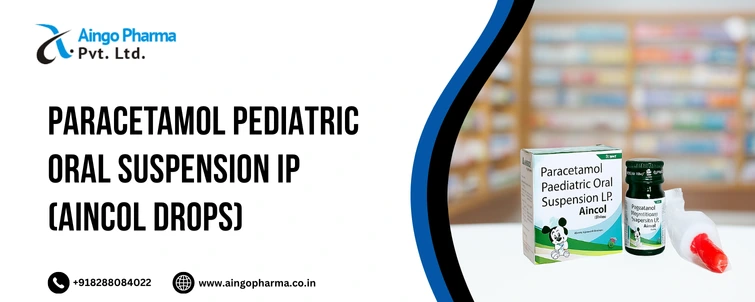



Paracetamol Pediatric Oral Suspension IP is a widely utilized medication designed to alleviate pain and reduce fever in children. This liquid formulation of paracetamol (also known as acetaminophen) is tailored for pediatric use, offering an effective and convenient option for young patients who may struggle with swallowing tablets.
The Blog on Paracetamol Pediatric Oral Suspension IP, covering its composition, therapeutic applications, mechanism of action, administration guidelines, potential side effects, safety precautions, and much more. Written with clarity and precision, this guide aims to empower parents, caregivers, and healthcare providers with the knowledge needed to use this medication safely and effectively.
Paracetamol Pediatric Oral Suspension IP Aingo Pharma‘s “Aincol Drops” is a liquid medication formulated specifically for children, containing paracetamol as its active ingredient. Paracetamol is a globally recognized analgesic (pain reliever) and antipyretic (fever reducer), trusted for its efficacy and safety when used appropriately. The “IP” in its name stands for Indian Pharmacopoeia, indicating that it adheres to the standards set by this regulatory body, though similar formulations are available worldwide under various pharmacopoeial guidelines.
This suspension is typically available in concentrations such as 120mg/5ml or 250mg/5ml, allowing for flexible dosing based on a child’s age and weight. Unlike tablets or capsules, the liquid form is easier to swallow and can be flavored (e.g., strawberry or orange) to improve palatability for children. As an over-the-counter (OTC) product, it is a staple in many households, used to address common childhood ailments like fever and mild pain.
Aincol Drops by Aingo Pharma is a trusted Paracetamol Pediatric Oral Suspension IP carefully formulated to provide gentle yet effective relief from fever and mild to moderate pain in infants and young children. Designed with a child-friendly taste and accurate dosing, Aincol Drops help parents manage their little one’s discomfort due to teething, colds, or post-vaccination fever.
With a focus on safety, precision, and ease of use, Aingo ensures each drop delivers fast-acting comfort while meeting strict GMP-certified quality standards—making Aincol a dependable choice for growing families.

Paracetamol Pediatric Oral Suspension IP serves two primary purposes: pain relief and fever reduction. Its versatility makes it a go-to solution for a range of pediatric conditions.
Common Uses
Key Benefits
Evidence supports its efficacy. For example, a clinical trial published in Pediatrics demonstrated that paracetamol effectively lowered fever in children within 30 minutes, with a sustained effect that supported rest and recovery. Its widespread use is also a testament to its reliability, as it remains a first-line treatment recommended by pediatricians globally.
Understanding how Paracetamol Pediatric Oral Suspension IP works provides insight into its effectiveness. Paracetamol exerts its effects primarily in the central nervous system.
Mechanism of Action
Why It’s Unique
Unlike NSAIDs, paracetamol has minimal anti-inflammatory action, which explains its focus on pain and fever rather than swelling or redness. Its action is centralized in the brain rather than at peripheral sites of injury, contributing to its gentle profile on the gastrointestinal system.
This mechanism ensures that the medication targets symptoms efficiently while maintaining a favorable safety profile for pediatric use when administered correctly.
Proper dosing is essential to maximize the benefits of Paracetamol Pediatric Oral Suspension IP while minimizing risks. Dosage varies based on the child’s age, weight, and the suspension’s strength.
Dosage Chart
Below is a general guide for common formulations. Always check the product label or consult a healthcare provider for specific instructions.
| Age Group | Weight (kg) | Dose (120mg/5ml) | Dose (250mg/5ml) |
| 2-3 months | 4-6 | 2.5ml | Not recommended |
| 3-6 months | 6-8 | 2.5ml | 1.2ml |
| 6-12 months | 8-10 | 5ml | 2.5ml |
| 1-2 years | 10-12 | 5ml | 2.5ml |
| 2-4 years | 12-16 | 7.5ml | 3.75ml |
| 4-6 years | 16-20 | 10ml | 5ml |
Administration Rules
Special Considerations
Caregivers must follow these guidelines diligently to ensure safe and effective treatment.
While Paracetamol Pediatric Oral Suspension IP is generally well-tolerated, it can cause side effects, particularly if misused.
Common Side Effects
These effects are typically mild and resolve on their own. If they persist, seek medical advice.
Overdose Risks
Excessive doses can lead to serious complications, primarily liver toxicity, due to paracetamol’s metabolism in the liver. Symptoms of overdose include:
Managing an Overdose
Prompt intervention is critical, as liver damage can be life-threatening but is often preventable with early treatment.
To ensure safe use, caregivers should be aware of the following precautions:
When to Avoid or Consult a Doctor
Practical Safety Tips
Adhering to these precautions minimizes risks and ensures the medication remains a safe choice.
How to Administer
Storage Guidelines
Proper handling enhances the medication’s effectiveness and safety.
Paracetamol Pediatric Oral Suspension IP is marketed under various brand names, each with unique features:
Choosing a Product
While the active ingredient remains the same, these factors can influence the experience of administration.

Q: What is Paracetamol Pediatric Oral Suspension IP used for?
A: It is commonly used to reduce fever and relieve mild to moderate pain in infants and children, including teething, colds, and post-vaccination fever. Products like Aincol by Aingo Pharma offer a reliable solution.
Q: Is Paracetamol safe for babies?
A: Yes, it is generally safe when used in the correct dose based on the child’s weight and age. Always follow your doctor’s guidance. Trusted formulations like Aincol Drops ensure both safety and ease of use.
Q: What is the correct dose for children?
A: The typical dose is 10–15 mg/kg every 4–6 hours, not exceeding 4 doses in 24 hours. Always consult a pediatrician. Many suspensions, including Aincol, come with dosing tools for accuracy.
Q: How often can it be given?
A: It can be administered every 4 to 6 hours, up to a maximum of 4 doses in 24 hours, unless advised otherwise by a healthcare provider.
Q: Can it be taken on an empty stomach?
A: Yes, it is gentle on the stomach and can be taken with or without food. This makes it convenient for children, especially in liquid formats like Aincol Pediatric Suspension.
Q: What are the common side effects?
A: Side effects are rare but may include nausea, rash, or mild allergic reactions. In case of any unusual symptoms, stop usage and consult a doctor.
Q: How quickly does it work?
A: Paracetamol generally begins to lower fever or reduce pain within 30 to 60 minutes of administration.
Q: Can it be used alongside other medications?
A: Avoid giving it with other products that contain Paracetamol to prevent overdose. Always check with a doctor before combining medicines.
Q: What should I do if a dose is missed?
A: Administer the missed dose as soon as possible. If it’s close to the next dose, skip it. Do not double the dose.
Q: What happens in case of an overdose?
A: Paracetamol overdose can lead to liver damage. Immediate medical attention is required, even if no symptoms are visible.
Q: How should this suspension be stored?
A: Store at 15–30°C, away from sunlight and moisture. Shake the bottle well before each use. Brands like Aincol by Aingo Pharma offer stable, easy-to-store formulations.
Q: What makes some pediatric suspensions better than others?
A: High-quality suspensions like Aincol Drops are GMP-certified, have a pleasant taste, offer precise dosing, and are trusted by pediatricians for their safety and effectiveness.
Paracetamol Pediatric Oral Suspension IP is a cornerstone of pediatric care, offering reliable relief from pain and fever when used responsibly. Its liquid form, tailored dosages, and favorable safety profile make it an invaluable tool for managing common childhood symptoms. By adhering to dosing instructions, monitoring for side effects, and consulting professionals when needed, caregivers can harness its benefits while safeguarding their child’s health. This comprehensive guide underscores the importance of informed use, ensuring that this trusted medication continues to support children’s well-being effectively.